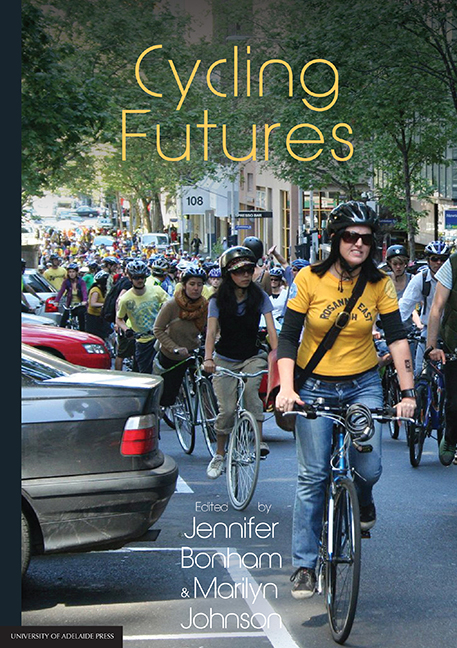Book contents
- Frontmatter
- Contents
- Preface
- Editors
- Contributors
- PART I Current challenges
- PART II Strategies for change
- 9 Gender and cycling: Gendering cycling subjects and forming bikes, practices and spaces as gendered objects
- 10 Making (up) the child cyclist: Bike Ed in South Australia
- 11 More than a message: Producing cyclists through public safety advertising campaigns
- 12 Spaces for cycling
- 13 Off-road cycling infrastructure
- 14 Teaching Australian civil engineers about cycling
- 15 What should planners know about cycling?
- 16 Skilling landscape architects and urban designers for design of bicycle parking and network facilities
- 17 Cycling and Australian law
17 - Cycling and Australian law
from PART II - Strategies for change
Published online by Cambridge University Press: 25 July 2017
- Frontmatter
- Contents
- Preface
- Editors
- Contributors
- PART I Current challenges
- PART II Strategies for change
- 9 Gender and cycling: Gendering cycling subjects and forming bikes, practices and spaces as gendered objects
- 10 Making (up) the child cyclist: Bike Ed in South Australia
- 11 More than a message: Producing cyclists through public safety advertising campaigns
- 12 Spaces for cycling
- 13 Off-road cycling infrastructure
- 14 Teaching Australian civil engineers about cycling
- 15 What should planners know about cycling?
- 16 Skilling landscape architects and urban designers for design of bicycle parking and network facilities
- 17 Cycling and Australian law
Summary
Introduction
Readers may expect this chapter to discuss laws about wearing a helmet, having lights and a bell, stopping at red lights and pedestrian crossings, using bicycle boxes, defined passing distance laws and other road safety rules. Some of these issues are mentioned, but they are not the focus of the discussion. Rather, the chapter is concerned with the law in relation to ‘making space for cycling’, and it is specifically aimed at those working on sustainable transport systems; academics responsible for designing courses about urban planning and transport; cycling and health promotion organisations; lobby groups; cycling advocates; and individuals interested in cycling safety. This chapter does not provide legal advice or information that can be relied upon in any legal situation.
The objective of this chapter is to stimulate thinking and provoke conversations by relevant stakeholders about the interface between the regulatory frameworks established by Australian law and the policy initiatives aimed at promoting sustainable transport and reducing death and injury of cyclists. This chapter argues that the current and future laws that apply to design and management of roads as well as road safety are key considerations in designing a road safety regulatory framework that makes space for sustainable and safe cycling in Australia. After a brief discussion of relevant concepts in Australia's legal system, the chapter examines some case studies to illustrate the current limitations of the law when cycling-related matters are dealt with by the courts. It introduces some of the laws that impact on cycling and then explores the role of the law in making space for cycling and the potential for reform in work health and safety laws to inform future regulatory frameworks in the context of cycling.
Fundamental concepts in Australian law
The legal system in Australia is a common law system, wherein laws are generally made through judges’ decisions (common law) and through legislation (statutory law) passed by the relevant parliament.
- Type
- Chapter
- Information
- Cycling Futures , pp. 407 - 428Publisher: The University of Adelaide PressPrint publication year: 2015

